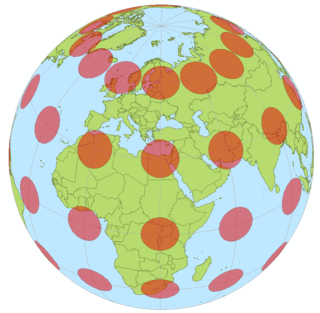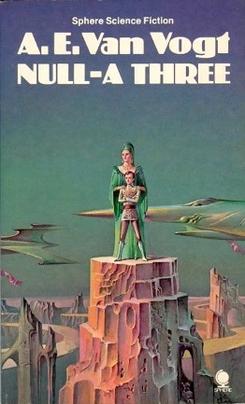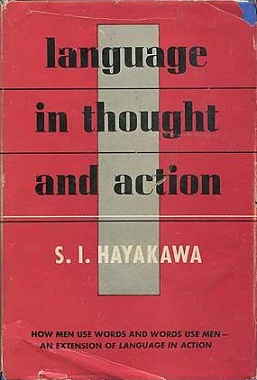
Alfred Habdank Skarbek Korzybski was a Polish-American independent scholar who developed a field called general semantics, which he viewed as both distinct from, and more encompassing than, the field of semantics. He argued that human knowledge of the world is limited both by the human nervous system and the languages humans have developed, and thus no one can have direct access to reality, given that the most we can know is that which is filtered through the brain's responses to reality. His best known dictum is "The map is not the territory".
Abstraction is a conceptual process wherein general rules and concepts are derived from the usage and classification of specific examples, literal signifiers, first principles, or other methods.
E-Prime denotes a restricted form of English in which authors avoid all forms of the verb to be.
Sanity refers to the soundness, rationality, and health of the human mind, as opposed to insanity. A person is sane if they are rational. In modern society, the term has become exclusively synonymous with compos mentis, in contrast with non compos mentis, or insanity, meaning troubled conscience. A sane mind is nowadays considered healthy both from its analytical - once called rational - and emotional aspects. According to the writer G. K. Chesterton, sanity involves wholeness, whereas insanity implies narrowness and brokenness.
The philosophy of mathematics is the branch of philosophy that studies the assumptions, foundations, and implications of mathematics. It aims to understand the nature and methods of mathematics, and find out the place of mathematics in people's lives. The logical and structural nature of mathematics makes this branch of philosophy broad and unique.
In computer science, abstract interpretation is a theory of sound approximation of the semantics of computer programs, based on monotonic functions over ordered sets, especially lattices. It can be viewed as a partial execution of a computer program which gains information about its semantics without performing all the calculations.
General semantics is concerned with how events translate to perceptions, how they are further modified by the names and labels we apply to them, and how we might gain a measure of control over our own cognitive, emotional, and behavioral responses. Proponents characterize general semantics as an antidote to certain kinds of delusional thought patterns in which incomplete and possibly warped mental constructs are projected onto the world and treated as reality itself. After partial launches under the names human engineering and humanology, Polish-American originator Alfred Korzybski (1879–1950) fully launched the program as general semantics in 1933 with the publication of Science and Sanity: An Introduction to Non-Aristotelian Systems and General Semantics.

The map–territory relation is the relationship between an object and a representation of that object, as in the relation between a geographical territory and a map of it. Mistaking the map for the territory is a logical fallacy that occurs when someone confuses the semantics of a term with what it represents. Polish-American scientist and philosopher Alfred Korzybski remarked that "the map is not the territory" and that "the word is not the thing", encapsulating his view that an abstraction derived from something, or a reaction to it, is not the thing itself. Korzybski held that many people do confuse maps with territories, that is, confuse conceptual models of reality with reality itself. These ideas are crucial to general semantics, a system Korzybski originated.
The study of how language influences thought has a long history in a variety of fields. There are two bodies of thought forming around this debate. One body of thought stems from linguistics and is known as the Sapir–Whorf hypothesis. There is a strong and a weak version of the hypothesis which argue for more or less influence of language on thought. The strong version, linguistic determinism, argues that without language there is and can be no thought, while the weak version, linguistic relativity, supports the idea that there are some influences from language on thought. And on the opposing side, there are 'language of thought' theories (LOTH) which believe that public language is inessential to private thought. LOTH theories address the debate of whether thought is possible without language which is related to the question of whether language evolved for thought. These ideas are difficult to study because it proves challenging to parse the effects of culture versus thought versus language in all academic fields.
Robert Paul Pula was a director emeritus of the Institute of General Semantics, author of A General-Semantics Glossary, and a composer. Pula served as the lead lecturer for the Institute of General Semantics for many years. He also edited the General Semantics Bulletin from 1977 to 1985, and served as the Director of the institute from 1983 to 1986. In 1993 he wrote the "Preface to the Fifth Edition" of Alfred Korzybski's Science and Sanity. He was a polymathic poet, painter, pianistic composer, Polka historian, Polish culturalist, cartoonist, writer, editor, and teacher.
Linguistic determinism is the concept that language and its structures limit and determine human knowledge or thought, as well as thought processes such as categorization, memory, and perception. The term implies that people's native languages will affect their thought process and therefore people will have different thought processes based on their mother tongues.

Process and Reality is a book by Alfred North Whitehead, in which the author propounds a philosophy of organism, also called process philosophy. The book, published in 1929, is a revision of the Gifford Lectures he gave in 1927–28.
We diverge from Descartes by holding that what he has described as primary attributes of physical bodies, are really the forms of internal relationships between actual occasions. Such a change of thought is the shift from materialism to Organic Realism, as a basic idea of physical science.

The semantic differential (SD) is a measurement scale designed to measure a person's subjective perception of, and affective reactions to, the properties of concepts, objects, and events by making use of a set of bipolar scales. The SD is used to assess one's opinions, attitudes, and values regarding these concepts, objects, and events in a controlled and valid way. Respondents are asked to choose where their position lies, on a set of scales with polar adjectives. Compared to other measurement scaling techniques such as Likert scaling, the SD can be assumed to be relatively reliable, valid, and robust.
The structural differential is a physical chart or three-dimensional model illustrating the abstracting processes of the human nervous system. In one form, it appears as a pegboard with tags. Created by Alfred Korzybski, and awarded a U.S. patent on May 26, 1925, it is used as a training device in general semantics. The device is intended to show that human "knowledge" of, or acquaintance with, anything is partial—not total.
The Institute of General Semantics (IGS) is a not-for-profit corporation established in 1938 by Alfred Korzybski, to support research and publication on the topic of general semantics. The Institute publishes Korzybski's writings, including the seminal text Science & Sanity, and books by other authors who have studied or taught general semantics, such as Robert Pula, Irving J. Lee, Wendell Johnson, and Stuart Chase. Every year since 1952, it has sponsored the Alfred Korzybski Memorial Lecture, with presenters from a broad range of disciplines, from science to medicine to entertainment, including names like actor Steve Allen, psychologist Albert Ellis, scientist and visionary R. Buckminster Fuller, linguist Allen Walker Read, and philosopher F. S. C. Northrop. The Institute offers periodic seminars, workshops and conferences and is headquartered in New York City.

Null-A Three, usually written Ā Three, is a 1985 science fiction novel by Canadian-American writer A. E. van Vogt. It incorporates concepts from the General semantics of Alfred Korzybski and refers to non-Aristotelian logic.

Language in Thought and Action is a 1949 book on General Semantics by Samuel Ichiye Hayakawa, based on his previous work Language in Action (1939). Early editions were written in consultation with different people. The 5th edition was published in 1991. It was updated by Hayakawa's son, Alan R. Hayakawa and has an introduction by Robert MacNeil. The book has sold over one million copies and has been translated into eight languages.
Insight into human symbolic behavior and into human interaction through symbolic mechanisms comes from all sorts of disciplines: not only from linguistics, philosophy, psychology, and cultural anthropology, but from attitude research and public opinion study, from new techniques in psychotherapy, from physiology and neurology, from mathematical biology and cybernetics. How are all these separate insights to be brought together? ...I have examined the problem long enough to believe that it cannot be done without some set of broad and informing principles such as is to be found in the General Semantics of Alfred Korzybski.
William Alanson White was an American neurologist and psychiatrist.
Marjorie Kendig Gates (1892–1981), best known as M. Kendig, was an American administrator, director of the Institute of General Semantics from 1950 until 1965, and co-worker of Alfred Korzybski, who developed the theory of general semantics. She completed Korzybski's collected writings after his death in 1950.
The term abstraction has a number of uses in the field of linguistics. It can denote a process in the development of language, whereby terms become used for concepts further removed from the objects to which they were originally attached. It can also denote a process applied by linguists themselves, whereby phenomena are considered without the details that are not relevant to the desired level of analysis.







